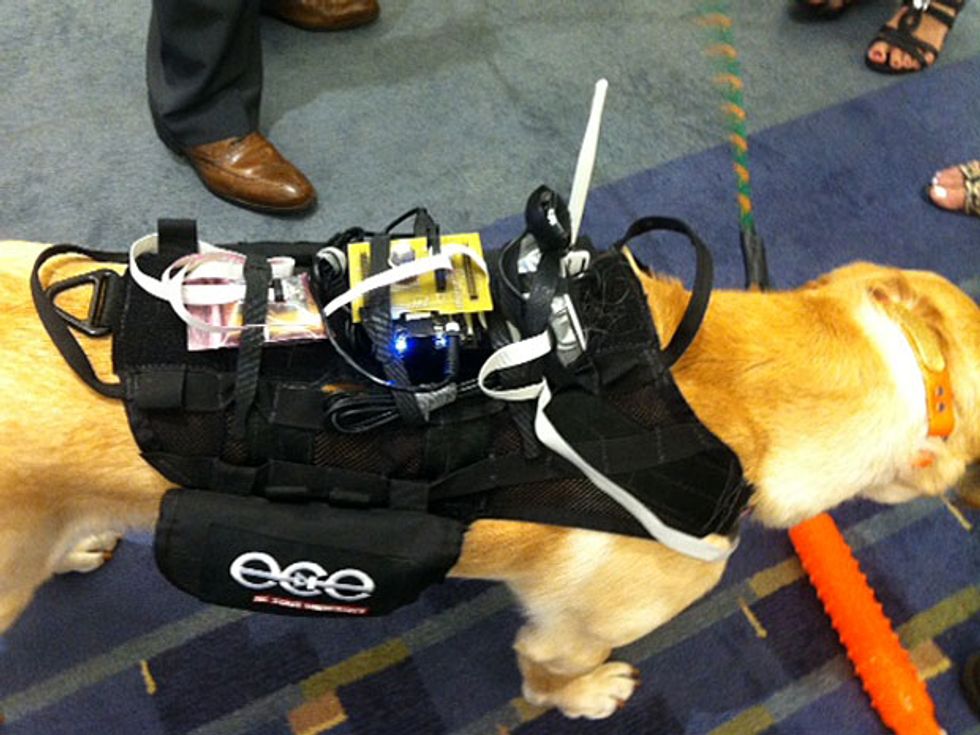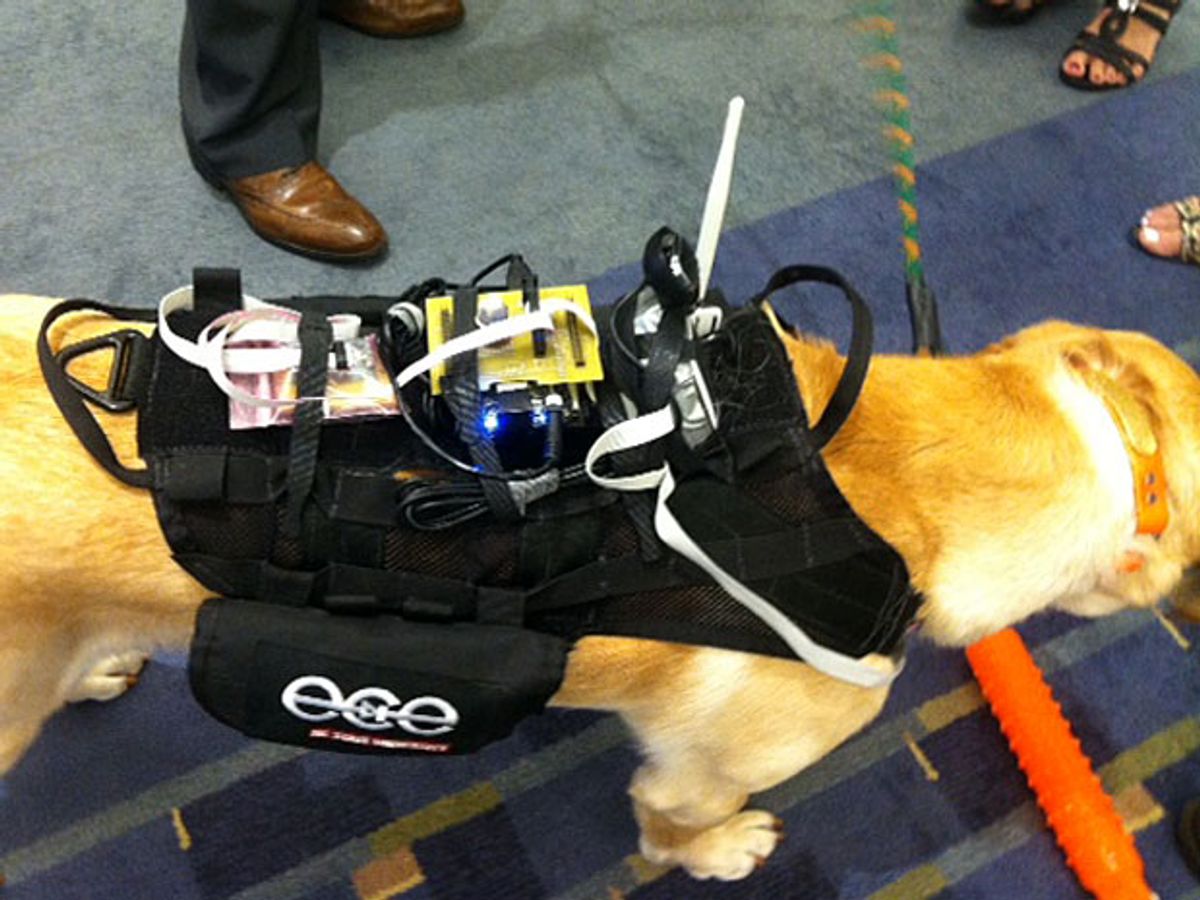
What do a dog packing a microprocessor, sensors, and batteries in its harness, a 2-meter-tall robot, and drones have in common? They, along with some 600 humans, attended the SmartAmerica Expo last week at the Walter E. Washington Convention Center, in Washington, D.C.
The expo was the culmination of a SmartAmerica Challenge, the brainchild of Presidential Innovation Fellows (PIFs) Geoff Mulligan and Sokwoo Rhee. The challenge was launched at the White House last December, bringing together dozens of industry, academic, and government organizations in a sort of “speed dating for the Internet of Things [IoT],” Mulligan told Expo attendees. The PIFs encouraged them to form teams and develop IoT projects that could create jobs, business opportunities, and socioeconomic benefits for the United States.
The PIF program brings technology experts from the private sector, nonprofits, and academia into government for up to a year, teaming them with civil servants in an effort to foster a more entrepreneurial approach to, and more innovation in, government. Mulligan and Rhee were appointed to work on a project involving cyberphysical systems—merging computers and sensors with physical infrastructure—at the National Institute of Standards and Technology.
Both Mulligan and Rhee have been involved in developing IoT technologies for years. Mulligan helped design the latest Internet protocol, IPv6. He was a founder of the ZigBee Alliance, which advocates for the ZigBee low-power communications standard, and he has worked on sensor and smart-grid projects for the U.S. government and various corporations. Rhee cofounded and was the chief technology officer of Millennial Net, which helped commercialize low-power wireless mesh networks.
“The hype [around IoT] far exceeds the delivery so far,” says Mulligan. Part of the problem is that individual organizations work in their own isolated environments, developing their own specialized products for a particular market, such as wearable electronics for health care. Neither the people nor the products are talking to one another. People do sometimes argue about whose protocol or product is the best, but that isn’t advancing the industry, he says. “We’ve built gizmo after gizmo, protocol after protocol, yet everyone keeps waiting for the next protocol or the next gizmo because that’ll make the IoT take off,” says Mulligan. By shining the national spotlight on these projects, Mulligan and Rhee hope to jump-start the kind of cross-sector cooperation that could move the industry forward. All told, 24 different teams, each with 1 to 10 participants, gave 10-minute presentations and demonstrated their projects on the exhibit floor.
One project that grabbed the spotlight was the Smart Emergency Response System, developed by a team of nine different organizations. The system combines search-and-rescue dogs, drones, and robots, which are all in communication with first responders. Dogs wearing wireless sensors are used to search rubble for casualties or to detect dangers such as a gas leak. A haptic device is used to remotely operate the robots to lift heavy objects, while the drones search the area by air.
The team—composed of BluHaptics, North Carolina State University, Boeing, the University of North Texas, MathWorks, the University of Washington, National Instruments, Worcester Polytechnic Institute, and the MIT Media Lab—epitomizes the kind of cross-fertilization that Mulligan and Rhee were hoping for.
“We talk about connecting things, but [until we start] connecting the people—the developers, researchers, government agencies—the industry will remain slow,” says Rhee. Meeting through the SmartAmerica Challenge, these organizations realized, “Hey, I’ve got a dog, you’ve got an unmanned autonomous vehicle, and you’ve got a robot,” says Mulligan. “Who would’ve thought they could bring all these things together?”
Todd Park, chief technology officer of the United States, made yet another comment about connections in his speech at the expo. He compared the potential of the IoT to the explosion of innovation that happened when people could communicate through the Internet on PCs and, later, smartphones. A similar burst of creativity will happen when a critical mass of physical things can communicate with one another via the Internet, he says. The 24 projects at the expo gave him hope that this could be the start of the kind of “thriving community of researchers, entrepreneurs, and innovators” that would help the country reach that stage.
About the Author
Contributing Editor Tam Harbert is a freelance journalist based in Washington, D.C., who specializes in technology and business. Her profile of legal artificial intelligence developer Lex Machina in the November 2013 issue won an award from the American Society of Journalists and Authors.
Freelance journalist Tam Harbert has covered technology and business for more than 20 years. Based in Washington, D.C., Harbert says her favorite type of article explains how public policy affects the technology business, or vice versa. She has launched, edited, and written for publications targeting engineers, IT managers, investors, and corporate executives. Harbert has won more than a dozen awards for her work, most recently two awards (2014) from the American Society of Business Publication Editors (ASBPE) and the American Society of Journalists and Authors (ASJA). She has also received the Jesse H. Neal Award for op-ed writing.



